Liabilities in Partnership Business
VerifiedAdded on 2022/12/05
|11
|2318
|146
AI Summary
This article discusses the liabilities that arise in a partnership business, including joint and several liability, liability for wrongful acts, and liability for misapplication of funds. It also explores the options for legal action and dissolution of the partnership.
Contribute Materials
Your contribution can guide someone’s learning journey. Share your
documents today.
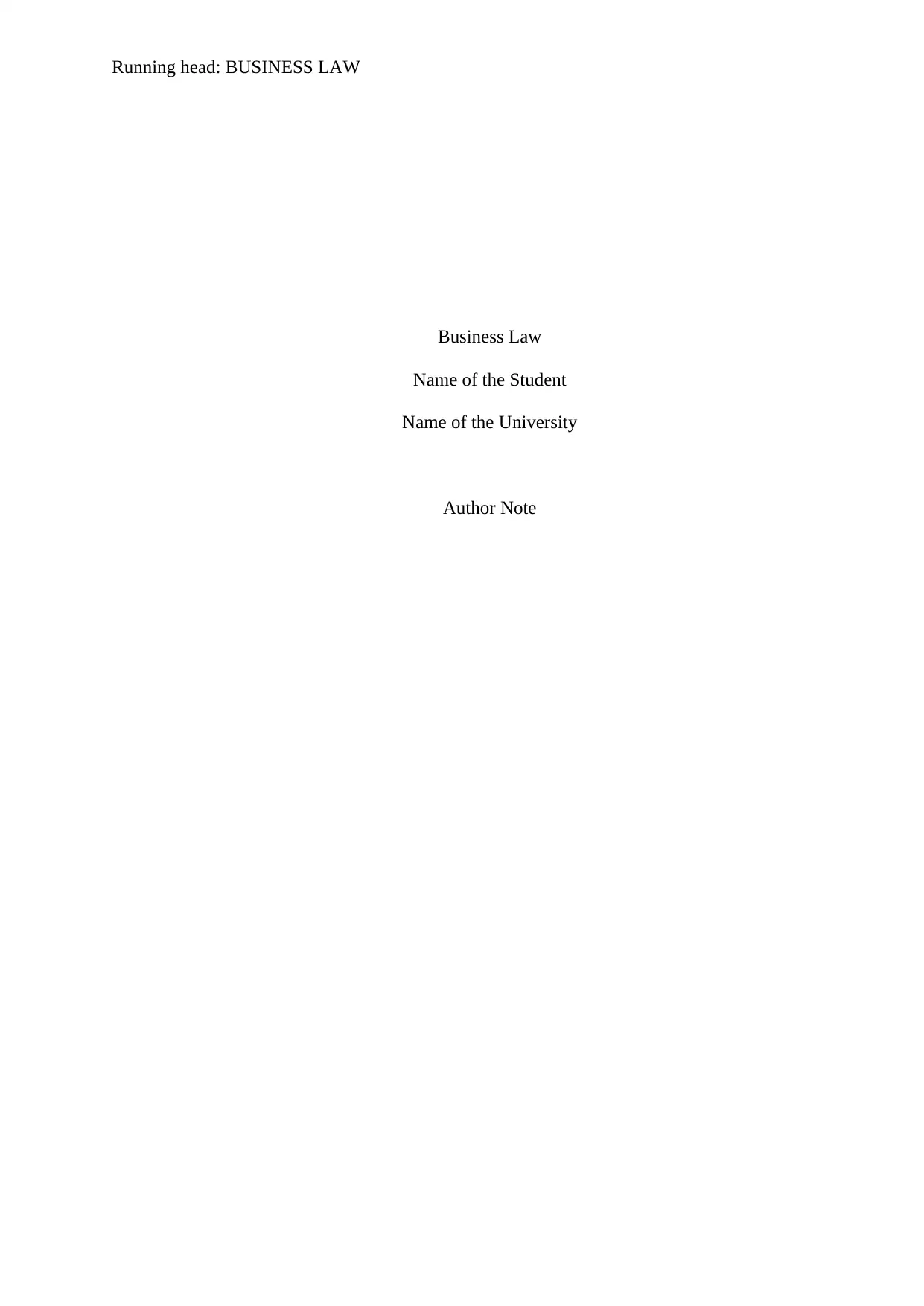
Running head: BUSINESS LAW
Business Law
Name of the Student
Name of the University
Author Note
Business Law
Name of the Student
Name of the University
Author Note
Secure Best Marks with AI Grader
Need help grading? Try our AI Grader for instant feedback on your assignments.
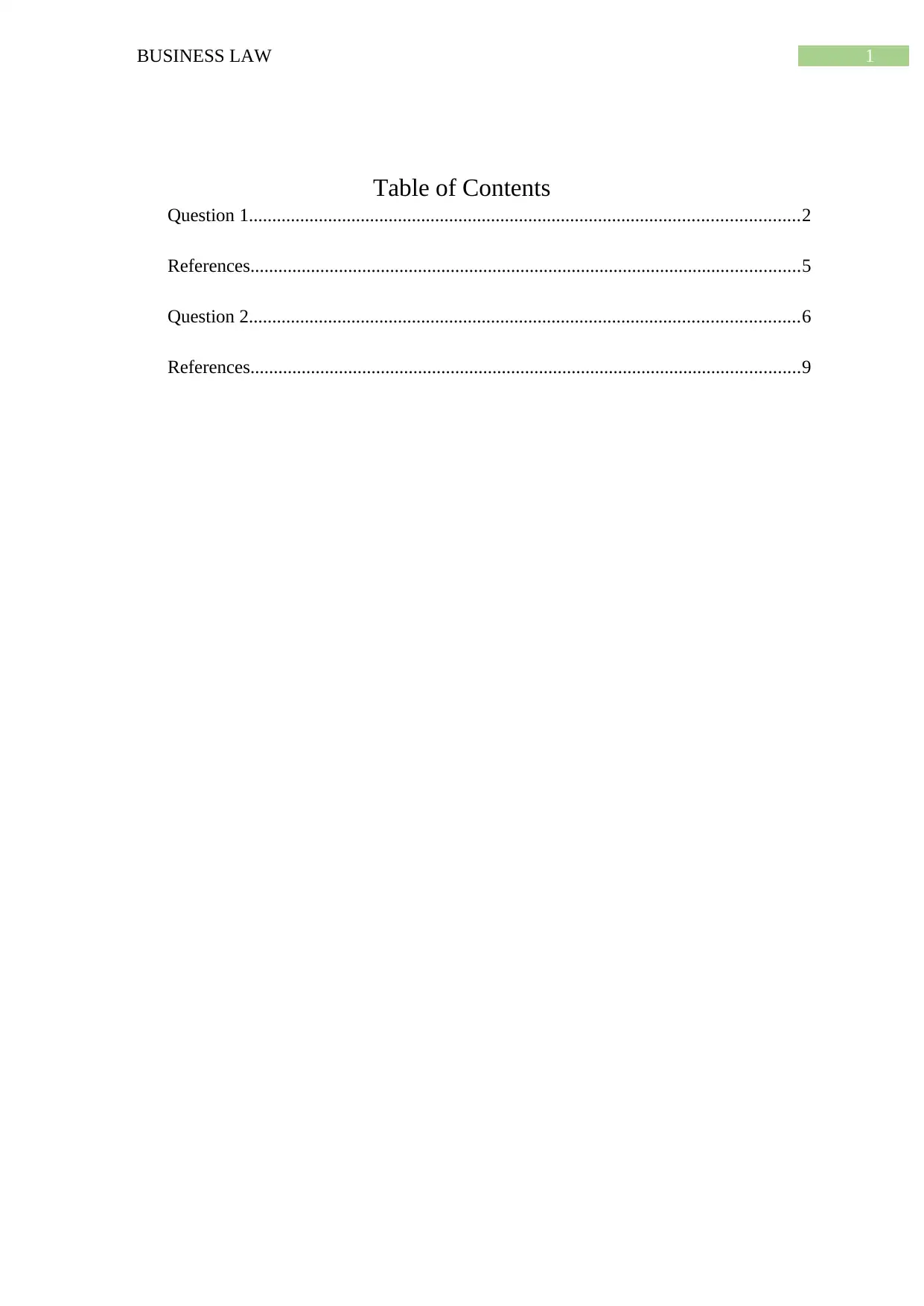
1BUSINESS LAW
Table of Contents
Question 1......................................................................................................................2
References......................................................................................................................5
Question 2......................................................................................................................6
References......................................................................................................................9
Table of Contents
Question 1......................................................................................................................2
References......................................................................................................................5
Question 2......................................................................................................................6
References......................................................................................................................9
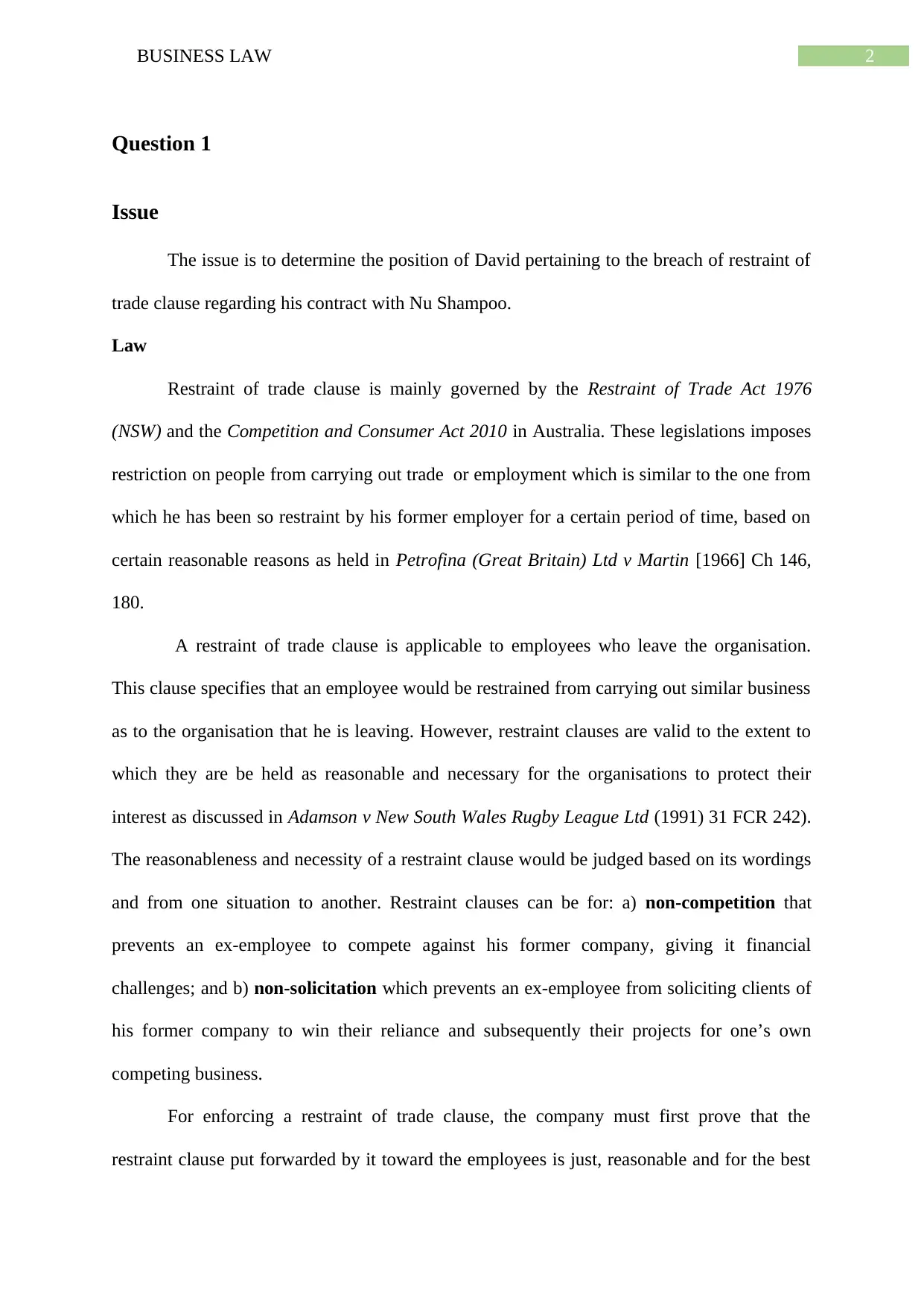
2BUSINESS LAW
Question 1
Issue
The issue is to determine the position of David pertaining to the breach of restraint of
trade clause regarding his contract with Nu Shampoo.
Law
Restraint of trade clause is mainly governed by the Restraint of Trade Act 1976
(NSW) and the Competition and Consumer Act 2010 in Australia. These legislations imposes
restriction on people from carrying out trade or employment which is similar to the one from
which he has been so restraint by his former employer for a certain period of time, based on
certain reasonable reasons as held in Petrofina (Great Britain) Ltd v Martin [1966] Ch 146,
180.
A restraint of trade clause is applicable to employees who leave the organisation.
This clause specifies that an employee would be restrained from carrying out similar business
as to the organisation that he is leaving. However, restraint clauses are valid to the extent to
which they are be held as reasonable and necessary for the organisations to protect their
interest as discussed in Adamson v New South Wales Rugby League Ltd (1991) 31 FCR 242).
The reasonableness and necessity of a restraint clause would be judged based on its wordings
and from one situation to another. Restraint clauses can be for: a) non-competition that
prevents an ex-employee to compete against his former company, giving it financial
challenges; and b) non-solicitation which prevents an ex-employee from soliciting clients of
his former company to win their reliance and subsequently their projects for one’s own
competing business.
For enforcing a restraint of trade clause, the company must first prove that the
restraint clause put forwarded by it toward the employees is just, reasonable and for the best
Question 1
Issue
The issue is to determine the position of David pertaining to the breach of restraint of
trade clause regarding his contract with Nu Shampoo.
Law
Restraint of trade clause is mainly governed by the Restraint of Trade Act 1976
(NSW) and the Competition and Consumer Act 2010 in Australia. These legislations imposes
restriction on people from carrying out trade or employment which is similar to the one from
which he has been so restraint by his former employer for a certain period of time, based on
certain reasonable reasons as held in Petrofina (Great Britain) Ltd v Martin [1966] Ch 146,
180.
A restraint of trade clause is applicable to employees who leave the organisation.
This clause specifies that an employee would be restrained from carrying out similar business
as to the organisation that he is leaving. However, restraint clauses are valid to the extent to
which they are be held as reasonable and necessary for the organisations to protect their
interest as discussed in Adamson v New South Wales Rugby League Ltd (1991) 31 FCR 242).
The reasonableness and necessity of a restraint clause would be judged based on its wordings
and from one situation to another. Restraint clauses can be for: a) non-competition that
prevents an ex-employee to compete against his former company, giving it financial
challenges; and b) non-solicitation which prevents an ex-employee from soliciting clients of
his former company to win their reliance and subsequently their projects for one’s own
competing business.
For enforcing a restraint of trade clause, the company must first prove that the
restraint clause put forwarded by it toward the employees is just, reasonable and for the best
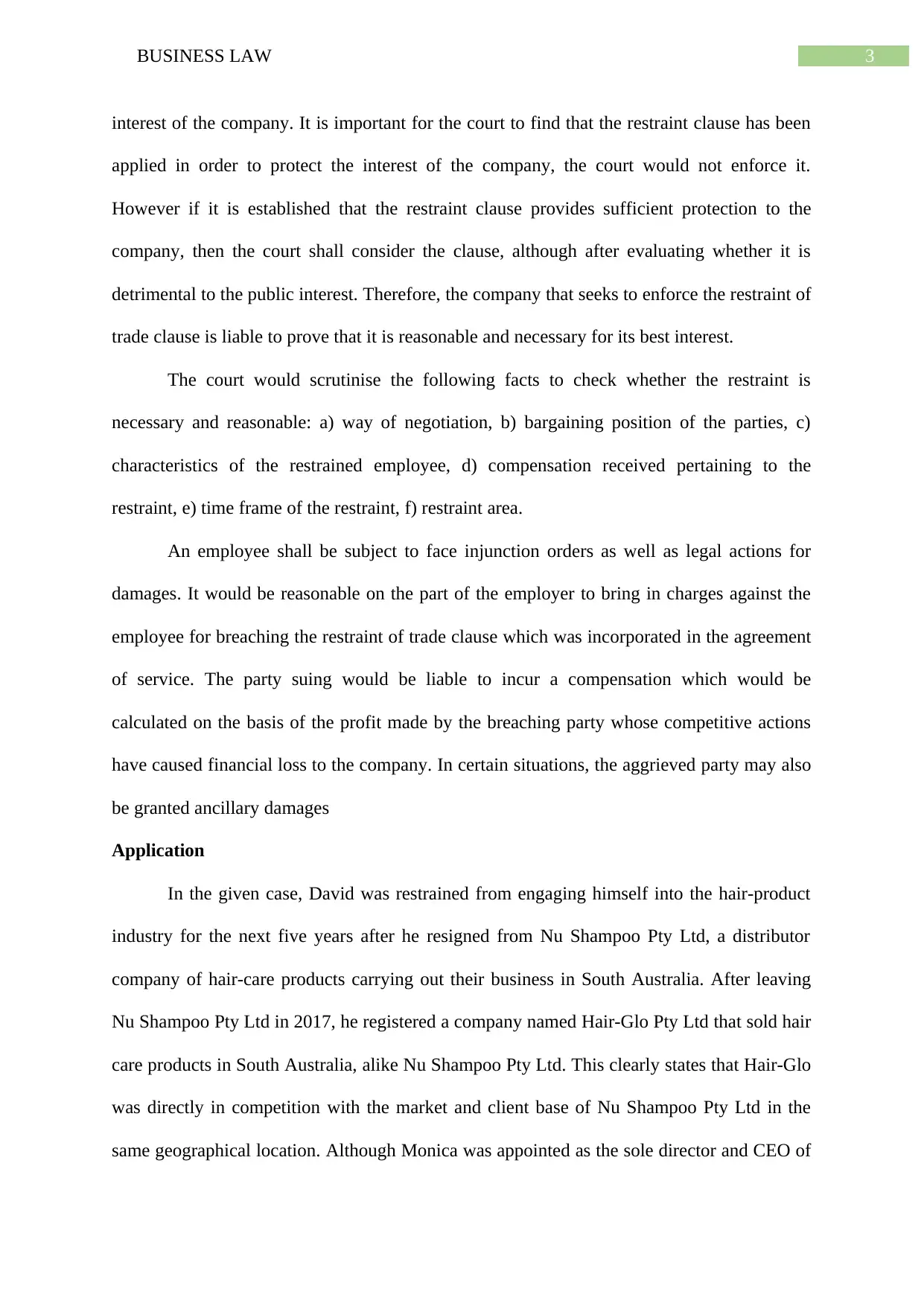
3BUSINESS LAW
interest of the company. It is important for the court to find that the restraint clause has been
applied in order to protect the interest of the company, the court would not enforce it.
However if it is established that the restraint clause provides sufficient protection to the
company, then the court shall consider the clause, although after evaluating whether it is
detrimental to the public interest. Therefore, the company that seeks to enforce the restraint of
trade clause is liable to prove that it is reasonable and necessary for its best interest.
The court would scrutinise the following facts to check whether the restraint is
necessary and reasonable: a) way of negotiation, b) bargaining position of the parties, c)
characteristics of the restrained employee, d) compensation received pertaining to the
restraint, e) time frame of the restraint, f) restraint area.
An employee shall be subject to face injunction orders as well as legal actions for
damages. It would be reasonable on the part of the employer to bring in charges against the
employee for breaching the restraint of trade clause which was incorporated in the agreement
of service. The party suing would be liable to incur a compensation which would be
calculated on the basis of the profit made by the breaching party whose competitive actions
have caused financial loss to the company. In certain situations, the aggrieved party may also
be granted ancillary damages
Application
In the given case, David was restrained from engaging himself into the hair-product
industry for the next five years after he resigned from Nu Shampoo Pty Ltd, a distributor
company of hair-care products carrying out their business in South Australia. After leaving
Nu Shampoo Pty Ltd in 2017, he registered a company named Hair-Glo Pty Ltd that sold hair
care products in South Australia, alike Nu Shampoo Pty Ltd. This clearly states that Hair-Glo
was directly in competition with the market and client base of Nu Shampoo Pty Ltd in the
same geographical location. Although Monica was appointed as the sole director and CEO of
interest of the company. It is important for the court to find that the restraint clause has been
applied in order to protect the interest of the company, the court would not enforce it.
However if it is established that the restraint clause provides sufficient protection to the
company, then the court shall consider the clause, although after evaluating whether it is
detrimental to the public interest. Therefore, the company that seeks to enforce the restraint of
trade clause is liable to prove that it is reasonable and necessary for its best interest.
The court would scrutinise the following facts to check whether the restraint is
necessary and reasonable: a) way of negotiation, b) bargaining position of the parties, c)
characteristics of the restrained employee, d) compensation received pertaining to the
restraint, e) time frame of the restraint, f) restraint area.
An employee shall be subject to face injunction orders as well as legal actions for
damages. It would be reasonable on the part of the employer to bring in charges against the
employee for breaching the restraint of trade clause which was incorporated in the agreement
of service. The party suing would be liable to incur a compensation which would be
calculated on the basis of the profit made by the breaching party whose competitive actions
have caused financial loss to the company. In certain situations, the aggrieved party may also
be granted ancillary damages
Application
In the given case, David was restrained from engaging himself into the hair-product
industry for the next five years after he resigned from Nu Shampoo Pty Ltd, a distributor
company of hair-care products carrying out their business in South Australia. After leaving
Nu Shampoo Pty Ltd in 2017, he registered a company named Hair-Glo Pty Ltd that sold hair
care products in South Australia, alike Nu Shampoo Pty Ltd. This clearly states that Hair-Glo
was directly in competition with the market and client base of Nu Shampoo Pty Ltd in the
same geographical location. Although Monica was appointed as the sole director and CEO of
Secure Best Marks with AI Grader
Need help grading? Try our AI Grader for instant feedback on your assignments.
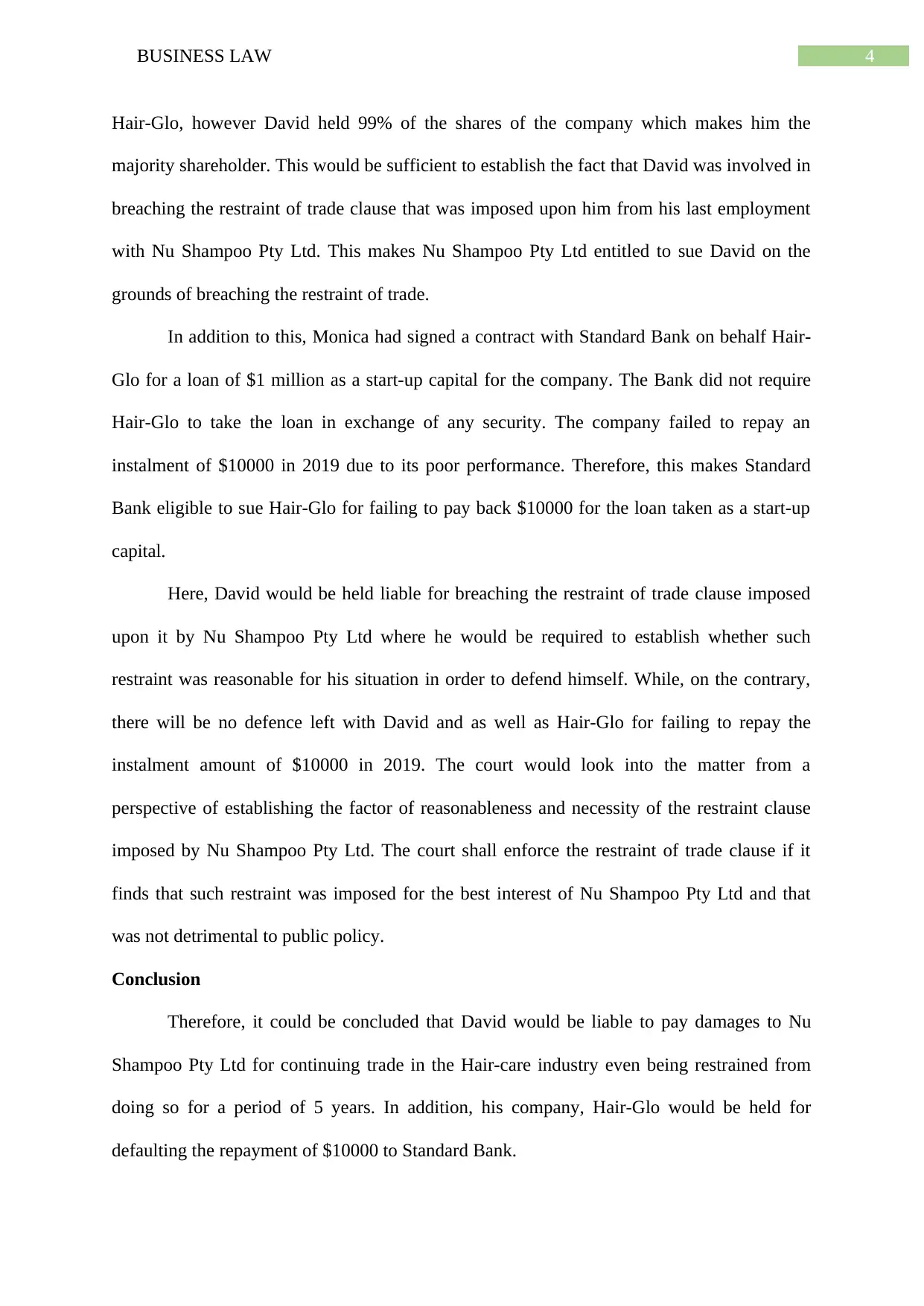
4BUSINESS LAW
Hair-Glo, however David held 99% of the shares of the company which makes him the
majority shareholder. This would be sufficient to establish the fact that David was involved in
breaching the restraint of trade clause that was imposed upon him from his last employment
with Nu Shampoo Pty Ltd. This makes Nu Shampoo Pty Ltd entitled to sue David on the
grounds of breaching the restraint of trade.
In addition to this, Monica had signed a contract with Standard Bank on behalf Hair-
Glo for a loan of $1 million as a start-up capital for the company. The Bank did not require
Hair-Glo to take the loan in exchange of any security. The company failed to repay an
instalment of $10000 in 2019 due to its poor performance. Therefore, this makes Standard
Bank eligible to sue Hair-Glo for failing to pay back $10000 for the loan taken as a start-up
capital.
Here, David would be held liable for breaching the restraint of trade clause imposed
upon it by Nu Shampoo Pty Ltd where he would be required to establish whether such
restraint was reasonable for his situation in order to defend himself. While, on the contrary,
there will be no defence left with David and as well as Hair-Glo for failing to repay the
instalment amount of $10000 in 2019. The court would look into the matter from a
perspective of establishing the factor of reasonableness and necessity of the restraint clause
imposed by Nu Shampoo Pty Ltd. The court shall enforce the restraint of trade clause if it
finds that such restraint was imposed for the best interest of Nu Shampoo Pty Ltd and that
was not detrimental to public policy.
Conclusion
Therefore, it could be concluded that David would be liable to pay damages to Nu
Shampoo Pty Ltd for continuing trade in the Hair-care industry even being restrained from
doing so for a period of 5 years. In addition, his company, Hair-Glo would be held for
defaulting the repayment of $10000 to Standard Bank.
Hair-Glo, however David held 99% of the shares of the company which makes him the
majority shareholder. This would be sufficient to establish the fact that David was involved in
breaching the restraint of trade clause that was imposed upon him from his last employment
with Nu Shampoo Pty Ltd. This makes Nu Shampoo Pty Ltd entitled to sue David on the
grounds of breaching the restraint of trade.
In addition to this, Monica had signed a contract with Standard Bank on behalf Hair-
Glo for a loan of $1 million as a start-up capital for the company. The Bank did not require
Hair-Glo to take the loan in exchange of any security. The company failed to repay an
instalment of $10000 in 2019 due to its poor performance. Therefore, this makes Standard
Bank eligible to sue Hair-Glo for failing to pay back $10000 for the loan taken as a start-up
capital.
Here, David would be held liable for breaching the restraint of trade clause imposed
upon it by Nu Shampoo Pty Ltd where he would be required to establish whether such
restraint was reasonable for his situation in order to defend himself. While, on the contrary,
there will be no defence left with David and as well as Hair-Glo for failing to repay the
instalment amount of $10000 in 2019. The court would look into the matter from a
perspective of establishing the factor of reasonableness and necessity of the restraint clause
imposed by Nu Shampoo Pty Ltd. The court shall enforce the restraint of trade clause if it
finds that such restraint was imposed for the best interest of Nu Shampoo Pty Ltd and that
was not detrimental to public policy.
Conclusion
Therefore, it could be concluded that David would be liable to pay damages to Nu
Shampoo Pty Ltd for continuing trade in the Hair-care industry even being restrained from
doing so for a period of 5 years. In addition, his company, Hair-Glo would be held for
defaulting the repayment of $10000 to Standard Bank.
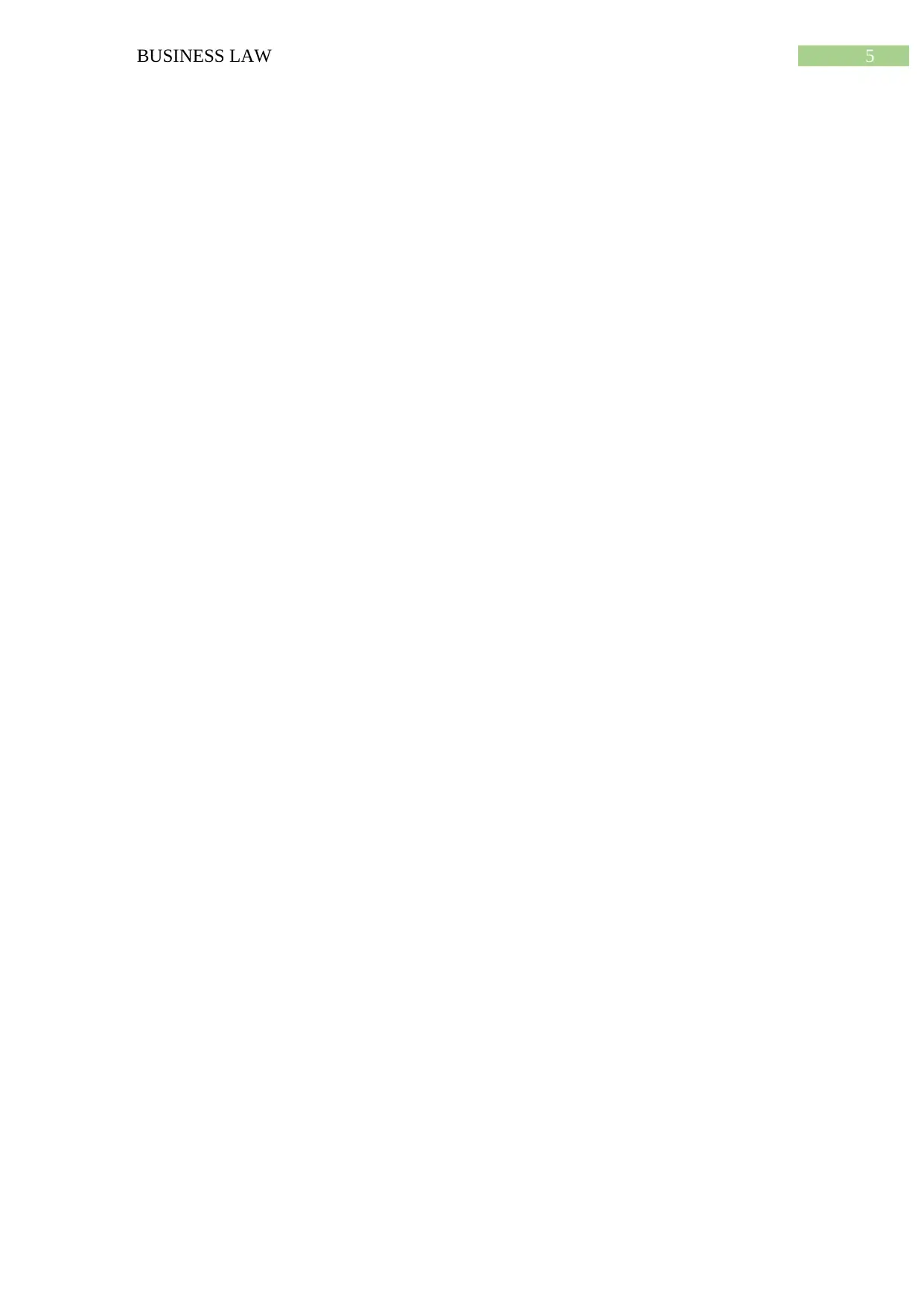
5BUSINESS LAW
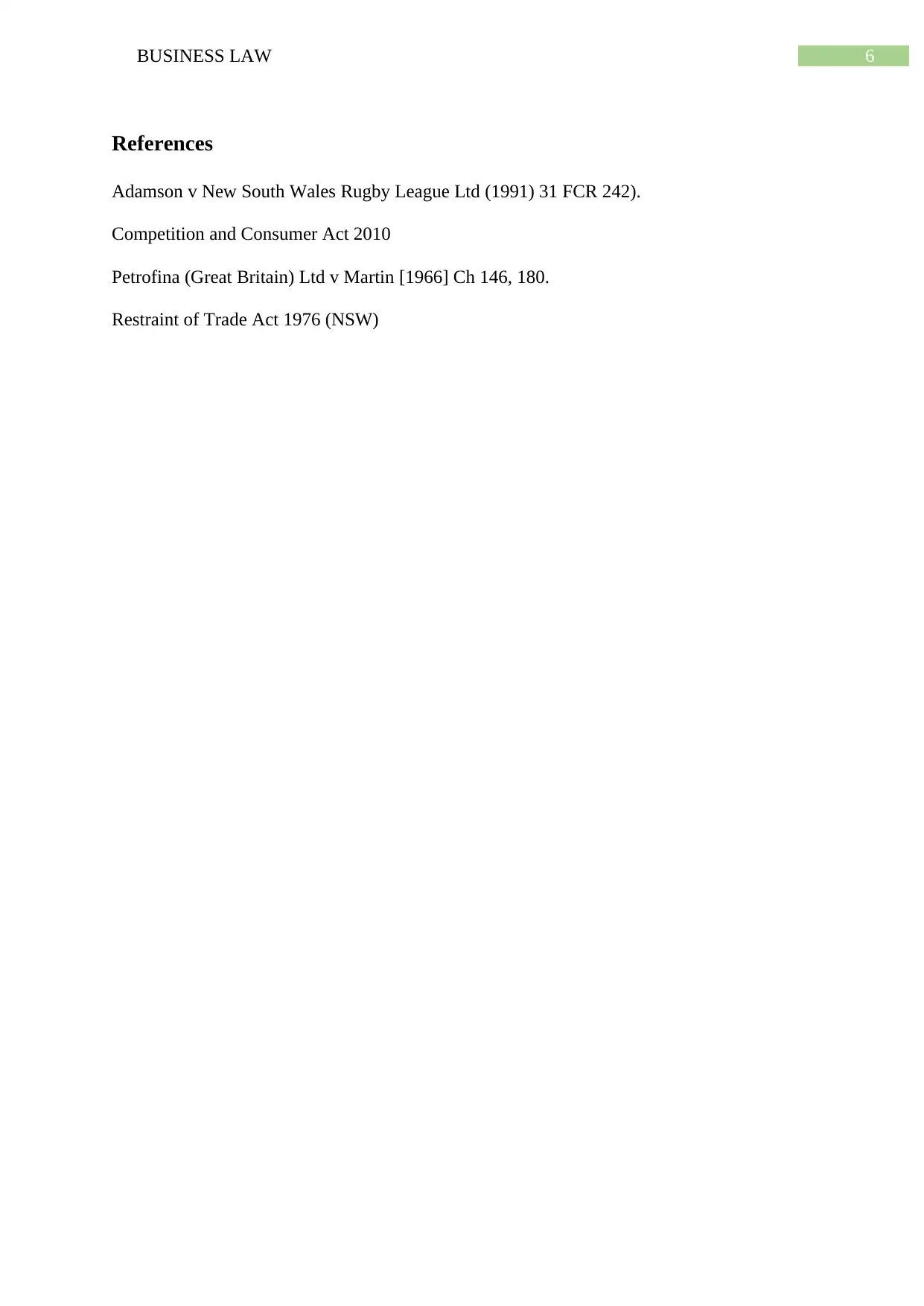
6BUSINESS LAW
References
Adamson v New South Wales Rugby League Ltd (1991) 31 FCR 242).
Competition and Consumer Act 2010
Petrofina (Great Britain) Ltd v Martin [1966] Ch 146, 180.
Restraint of Trade Act 1976 (NSW)
References
Adamson v New South Wales Rugby League Ltd (1991) 31 FCR 242).
Competition and Consumer Act 2010
Petrofina (Great Britain) Ltd v Martin [1966] Ch 146, 180.
Restraint of Trade Act 1976 (NSW)
Paraphrase This Document
Need a fresh take? Get an instant paraphrase of this document with our AI Paraphraser
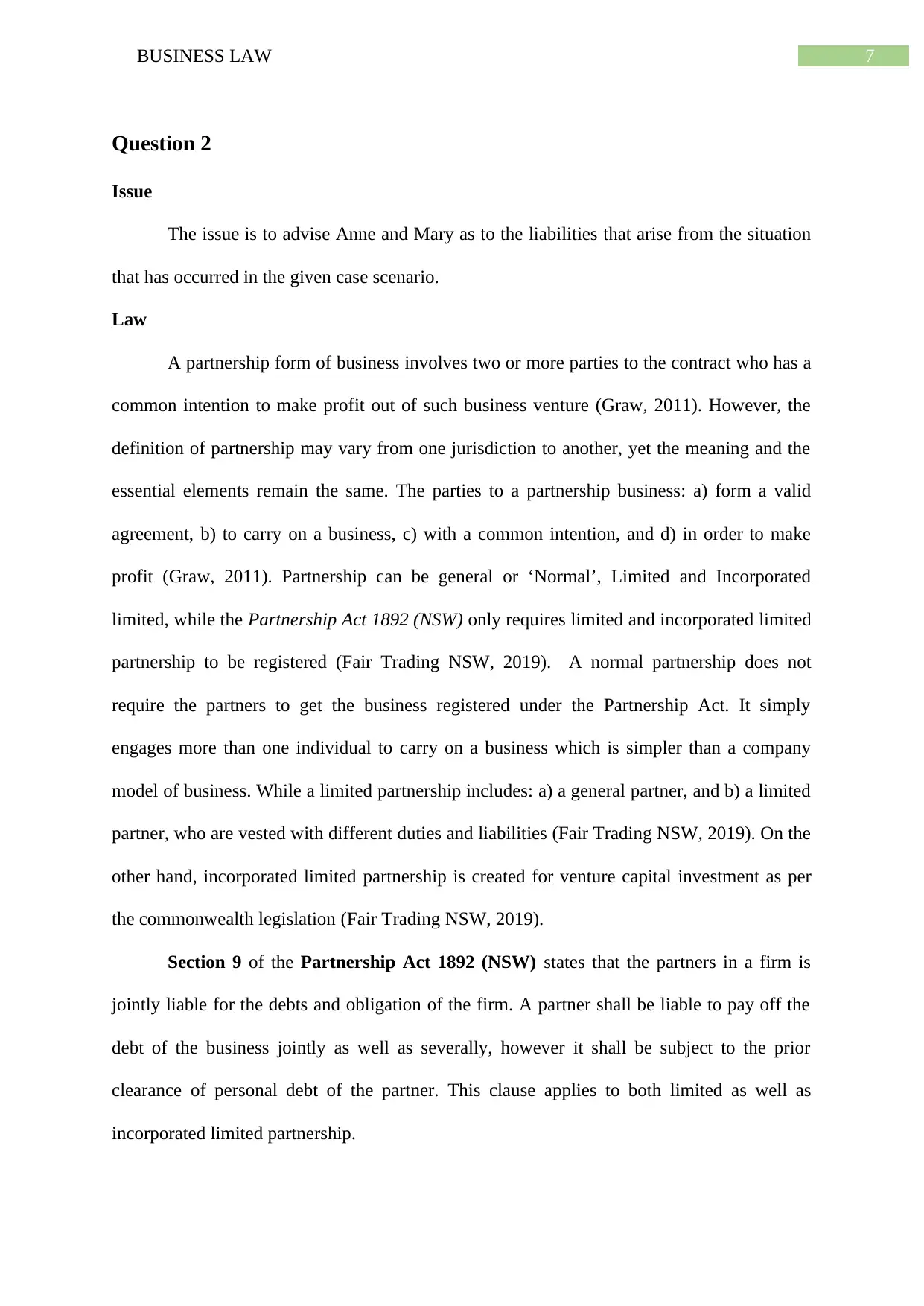
7BUSINESS LAW
Question 2
Issue
The issue is to advise Anne and Mary as to the liabilities that arise from the situation
that has occurred in the given case scenario.
Law
A partnership form of business involves two or more parties to the contract who has a
common intention to make profit out of such business venture (Graw, 2011). However, the
definition of partnership may vary from one jurisdiction to another, yet the meaning and the
essential elements remain the same. The parties to a partnership business: a) form a valid
agreement, b) to carry on a business, c) with a common intention, and d) in order to make
profit (Graw, 2011). Partnership can be general or ‘Normal’, Limited and Incorporated
limited, while the Partnership Act 1892 (NSW) only requires limited and incorporated limited
partnership to be registered (Fair Trading NSW, 2019). A normal partnership does not
require the partners to get the business registered under the Partnership Act. It simply
engages more than one individual to carry on a business which is simpler than a company
model of business. While a limited partnership includes: a) a general partner, and b) a limited
partner, who are vested with different duties and liabilities (Fair Trading NSW, 2019). On the
other hand, incorporated limited partnership is created for venture capital investment as per
the commonwealth legislation (Fair Trading NSW, 2019).
Section 9 of the Partnership Act 1892 (NSW) states that the partners in a firm is
jointly liable for the debts and obligation of the firm. A partner shall be liable to pay off the
debt of the business jointly as well as severally, however it shall be subject to the prior
clearance of personal debt of the partner. This clause applies to both limited as well as
incorporated limited partnership.
Question 2
Issue
The issue is to advise Anne and Mary as to the liabilities that arise from the situation
that has occurred in the given case scenario.
Law
A partnership form of business involves two or more parties to the contract who has a
common intention to make profit out of such business venture (Graw, 2011). However, the
definition of partnership may vary from one jurisdiction to another, yet the meaning and the
essential elements remain the same. The parties to a partnership business: a) form a valid
agreement, b) to carry on a business, c) with a common intention, and d) in order to make
profit (Graw, 2011). Partnership can be general or ‘Normal’, Limited and Incorporated
limited, while the Partnership Act 1892 (NSW) only requires limited and incorporated limited
partnership to be registered (Fair Trading NSW, 2019). A normal partnership does not
require the partners to get the business registered under the Partnership Act. It simply
engages more than one individual to carry on a business which is simpler than a company
model of business. While a limited partnership includes: a) a general partner, and b) a limited
partner, who are vested with different duties and liabilities (Fair Trading NSW, 2019). On the
other hand, incorporated limited partnership is created for venture capital investment as per
the commonwealth legislation (Fair Trading NSW, 2019).
Section 9 of the Partnership Act 1892 (NSW) states that the partners in a firm is
jointly liable for the debts and obligation of the firm. A partner shall be liable to pay off the
debt of the business jointly as well as severally, however it shall be subject to the prior
clearance of personal debt of the partner. This clause applies to both limited as well as
incorporated limited partnership.
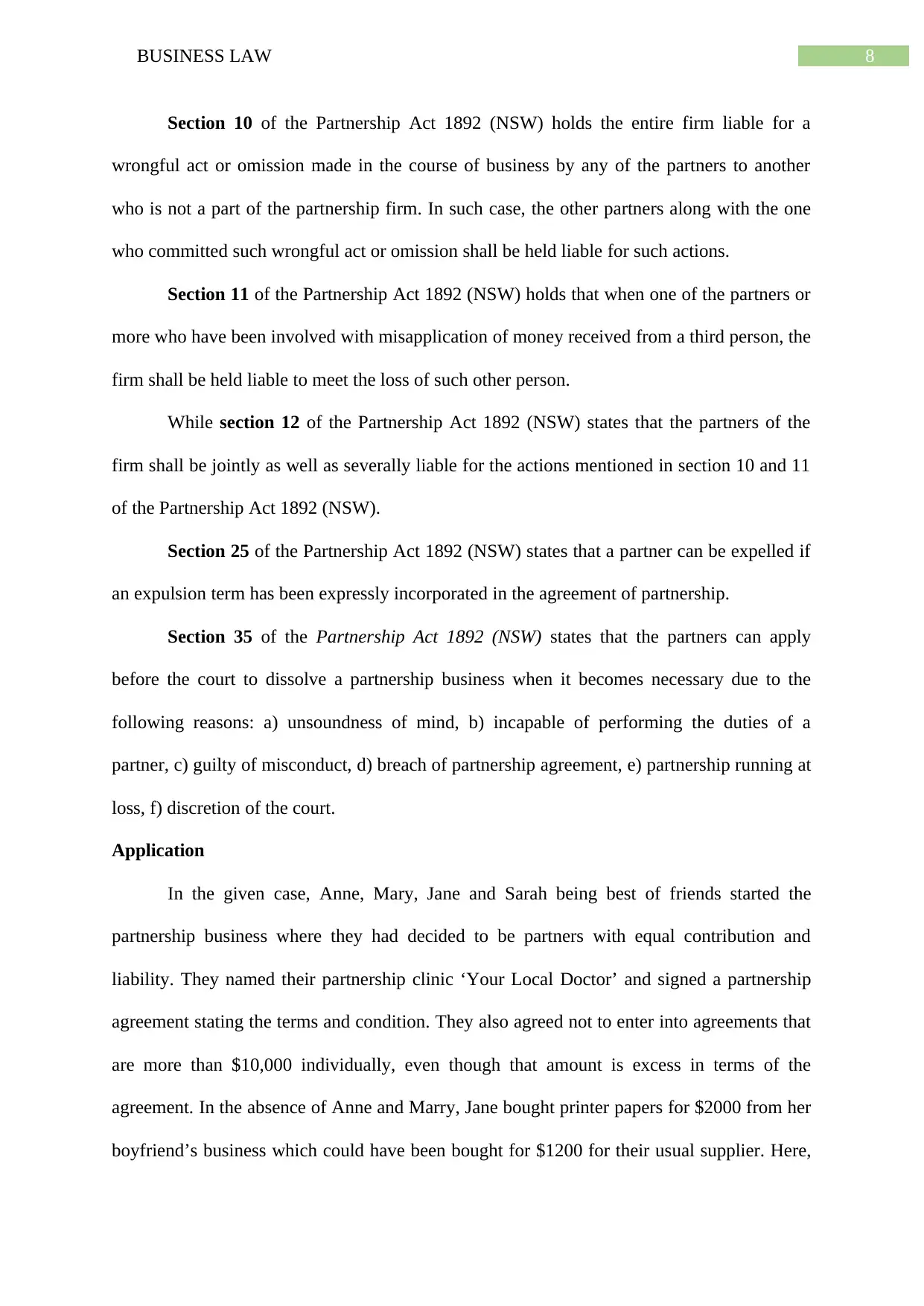
8BUSINESS LAW
Section 10 of the Partnership Act 1892 (NSW) holds the entire firm liable for a
wrongful act or omission made in the course of business by any of the partners to another
who is not a part of the partnership firm. In such case, the other partners along with the one
who committed such wrongful act or omission shall be held liable for such actions.
Section 11 of the Partnership Act 1892 (NSW) holds that when one of the partners or
more who have been involved with misapplication of money received from a third person, the
firm shall be held liable to meet the loss of such other person.
While section 12 of the Partnership Act 1892 (NSW) states that the partners of the
firm shall be jointly as well as severally liable for the actions mentioned in section 10 and 11
of the Partnership Act 1892 (NSW).
Section 25 of the Partnership Act 1892 (NSW) states that a partner can be expelled if
an expulsion term has been expressly incorporated in the agreement of partnership.
Section 35 of the Partnership Act 1892 (NSW) states that the partners can apply
before the court to dissolve a partnership business when it becomes necessary due to the
following reasons: a) unsoundness of mind, b) incapable of performing the duties of a
partner, c) guilty of misconduct, d) breach of partnership agreement, e) partnership running at
loss, f) discretion of the court.
Application
In the given case, Anne, Mary, Jane and Sarah being best of friends started the
partnership business where they had decided to be partners with equal contribution and
liability. They named their partnership clinic ‘Your Local Doctor’ and signed a partnership
agreement stating the terms and condition. They also agreed not to enter into agreements that
are more than $10,000 individually, even though that amount is excess in terms of the
agreement. In the absence of Anne and Marry, Jane bought printer papers for $2000 from her
boyfriend’s business which could have been bought for $1200 for their usual supplier. Here,
Section 10 of the Partnership Act 1892 (NSW) holds the entire firm liable for a
wrongful act or omission made in the course of business by any of the partners to another
who is not a part of the partnership firm. In such case, the other partners along with the one
who committed such wrongful act or omission shall be held liable for such actions.
Section 11 of the Partnership Act 1892 (NSW) holds that when one of the partners or
more who have been involved with misapplication of money received from a third person, the
firm shall be held liable to meet the loss of such other person.
While section 12 of the Partnership Act 1892 (NSW) states that the partners of the
firm shall be jointly as well as severally liable for the actions mentioned in section 10 and 11
of the Partnership Act 1892 (NSW).
Section 25 of the Partnership Act 1892 (NSW) states that a partner can be expelled if
an expulsion term has been expressly incorporated in the agreement of partnership.
Section 35 of the Partnership Act 1892 (NSW) states that the partners can apply
before the court to dissolve a partnership business when it becomes necessary due to the
following reasons: a) unsoundness of mind, b) incapable of performing the duties of a
partner, c) guilty of misconduct, d) breach of partnership agreement, e) partnership running at
loss, f) discretion of the court.
Application
In the given case, Anne, Mary, Jane and Sarah being best of friends started the
partnership business where they had decided to be partners with equal contribution and
liability. They named their partnership clinic ‘Your Local Doctor’ and signed a partnership
agreement stating the terms and condition. They also agreed not to enter into agreements that
are more than $10,000 individually, even though that amount is excess in terms of the
agreement. In the absence of Anne and Marry, Jane bought printer papers for $2000 from her
boyfriend’s business which could have been bought for $1200 for their usual supplier. Here,
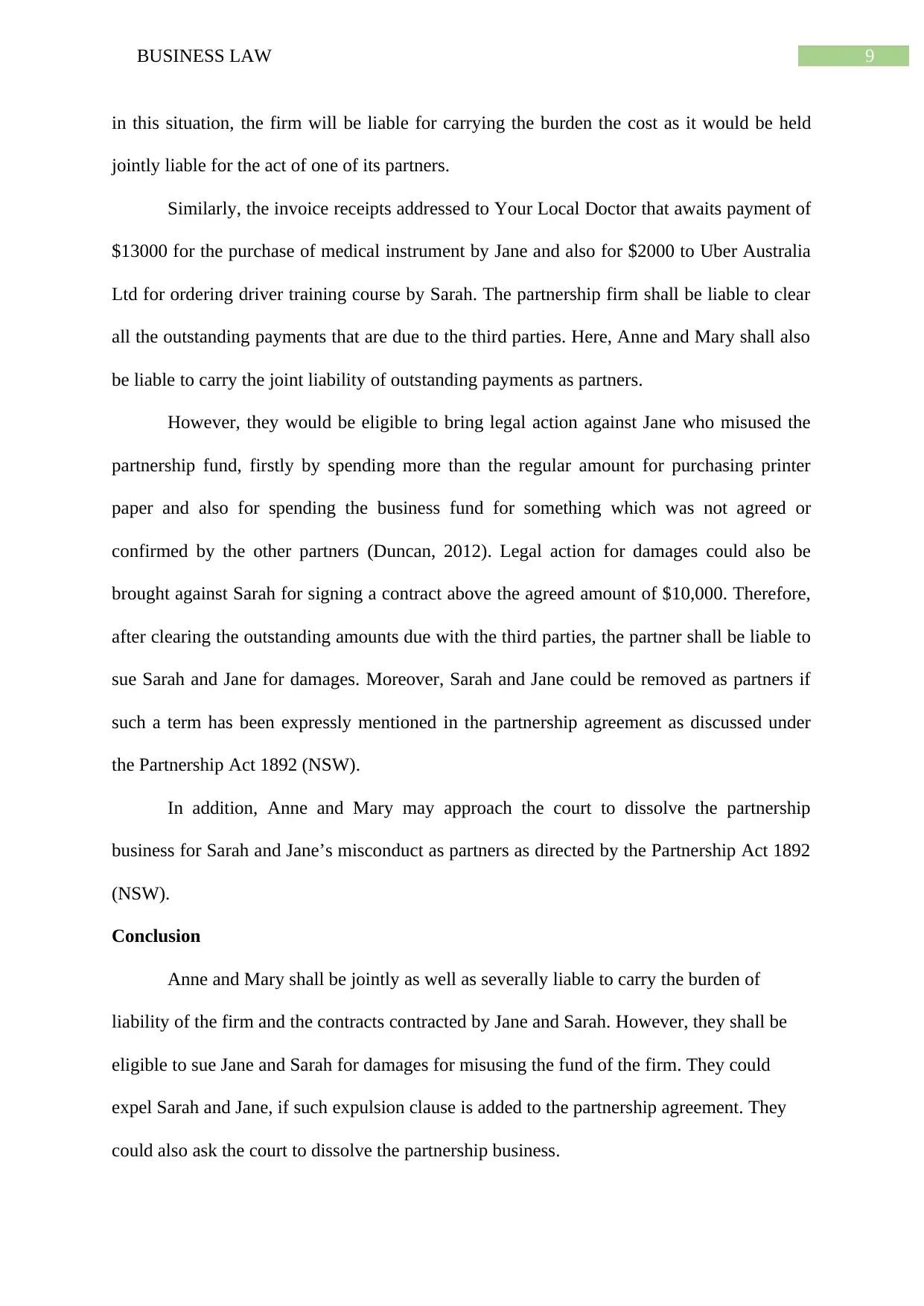
9BUSINESS LAW
in this situation, the firm will be liable for carrying the burden the cost as it would be held
jointly liable for the act of one of its partners.
Similarly, the invoice receipts addressed to Your Local Doctor that awaits payment of
$13000 for the purchase of medical instrument by Jane and also for $2000 to Uber Australia
Ltd for ordering driver training course by Sarah. The partnership firm shall be liable to clear
all the outstanding payments that are due to the third parties. Here, Anne and Mary shall also
be liable to carry the joint liability of outstanding payments as partners.
However, they would be eligible to bring legal action against Jane who misused the
partnership fund, firstly by spending more than the regular amount for purchasing printer
paper and also for spending the business fund for something which was not agreed or
confirmed by the other partners (Duncan, 2012). Legal action for damages could also be
brought against Sarah for signing a contract above the agreed amount of $10,000. Therefore,
after clearing the outstanding amounts due with the third parties, the partner shall be liable to
sue Sarah and Jane for damages. Moreover, Sarah and Jane could be removed as partners if
such a term has been expressly mentioned in the partnership agreement as discussed under
the Partnership Act 1892 (NSW).
In addition, Anne and Mary may approach the court to dissolve the partnership
business for Sarah and Jane’s misconduct as partners as directed by the Partnership Act 1892
(NSW).
Conclusion
Anne and Mary shall be jointly as well as severally liable to carry the burden of
liability of the firm and the contracts contracted by Jane and Sarah. However, they shall be
eligible to sue Jane and Sarah for damages for misusing the fund of the firm. They could
expel Sarah and Jane, if such expulsion clause is added to the partnership agreement. They
could also ask the court to dissolve the partnership business.
in this situation, the firm will be liable for carrying the burden the cost as it would be held
jointly liable for the act of one of its partners.
Similarly, the invoice receipts addressed to Your Local Doctor that awaits payment of
$13000 for the purchase of medical instrument by Jane and also for $2000 to Uber Australia
Ltd for ordering driver training course by Sarah. The partnership firm shall be liable to clear
all the outstanding payments that are due to the third parties. Here, Anne and Mary shall also
be liable to carry the joint liability of outstanding payments as partners.
However, they would be eligible to bring legal action against Jane who misused the
partnership fund, firstly by spending more than the regular amount for purchasing printer
paper and also for spending the business fund for something which was not agreed or
confirmed by the other partners (Duncan, 2012). Legal action for damages could also be
brought against Sarah for signing a contract above the agreed amount of $10,000. Therefore,
after clearing the outstanding amounts due with the third parties, the partner shall be liable to
sue Sarah and Jane for damages. Moreover, Sarah and Jane could be removed as partners if
such a term has been expressly mentioned in the partnership agreement as discussed under
the Partnership Act 1892 (NSW).
In addition, Anne and Mary may approach the court to dissolve the partnership
business for Sarah and Jane’s misconduct as partners as directed by the Partnership Act 1892
(NSW).
Conclusion
Anne and Mary shall be jointly as well as severally liable to carry the burden of
liability of the firm and the contracts contracted by Jane and Sarah. However, they shall be
eligible to sue Jane and Sarah for damages for misusing the fund of the firm. They could
expel Sarah and Jane, if such expulsion clause is added to the partnership agreement. They
could also ask the court to dissolve the partnership business.
Secure Best Marks with AI Grader
Need help grading? Try our AI Grader for instant feedback on your assignments.
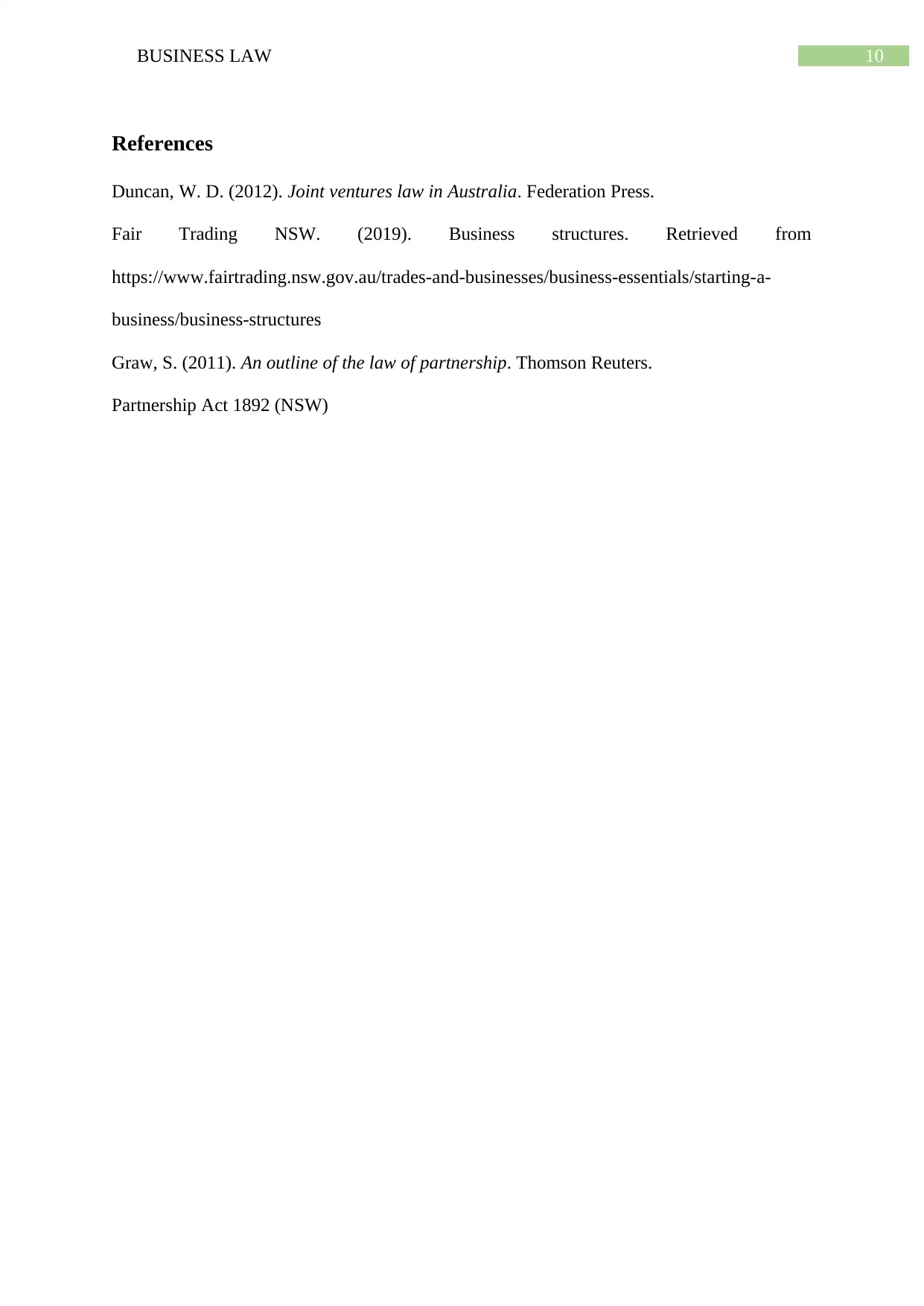
10BUSINESS LAW
References
Duncan, W. D. (2012). Joint ventures law in Australia. Federation Press.
Fair Trading NSW. (2019). Business structures. Retrieved from
https://www.fairtrading.nsw.gov.au/trades-and-businesses/business-essentials/starting-a-
business/business-structures
Graw, S. (2011). An outline of the law of partnership. Thomson Reuters.
Partnership Act 1892 (NSW)
References
Duncan, W. D. (2012). Joint ventures law in Australia. Federation Press.
Fair Trading NSW. (2019). Business structures. Retrieved from
https://www.fairtrading.nsw.gov.au/trades-and-businesses/business-essentials/starting-a-
business/business-structures
Graw, S. (2011). An outline of the law of partnership. Thomson Reuters.
Partnership Act 1892 (NSW)
1 out of 11
Your All-in-One AI-Powered Toolkit for Academic Success.
+13062052269
info@desklib.com
Available 24*7 on WhatsApp / Email
![[object Object]](/_next/static/media/star-bottom.7253800d.svg)
Unlock your academic potential
© 2024 | Zucol Services PVT LTD | All rights reserved.





